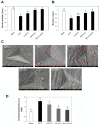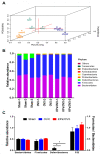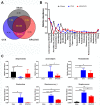Kefir Peptides Prevent Estrogen Deficiency-Induced Bone Loss and Modulate the Structure of the Gut Microbiota in Ovariectomized Mice
- PMID: 33182364
- PMCID: PMC7695289
- DOI: 10.3390/nu12113432
Kefir Peptides Prevent Estrogen Deficiency-Induced Bone Loss and Modulate the Structure of the Gut Microbiota in Ovariectomized Mice
Abstract
Osteoporosis is a major skeletal disease associated with estrogen deficiency in postmenopausal women. Kefir-fermented peptides (KPs) are bioactive peptides with health-promoting benefits that are produced from the degradation of dairy milk proteins by the probiotic microflora in kefir grains. This study aimed to evaluate the effects of KPs on osteoporosis prevention and the modulation of the composition of the gut microbiota in ovariectomized (OVX) mice. OVX mice receiving an 8-week oral gavage of 100 mg of KPs and 100 mg of KPs + 10 mg Ca exhibited lower trabecular separation (Tb. Sp), and higher bone mineral density (BMD), trabecular number (Tb. N) and bone volume (BV/TV), than OVX groups receiving Ca alone and untreated mice, and these effects were also reflected in bones with better mechanical properties of strength and fracture toughness. The gut microbiota of the cecal contents was examined by 16S rDNA amplicon sequencing. α-Diversity analysis indicated that the gut microbiota of OVX mice was enriched more than that of sham mice, but the diversity was not changed significantly. Treatment with KPs caused increased microbiota richness and diversity in OVX mice compared with those in sham mice. The microbiota composition changed markedly in OVX mice compared with that in sham mice. Following the oral administration of KPs for 8 weeks, the abundances of Alloprevotella, Anaerostipes, Parasutterella, Romboutsia, Ruminococcus_1 and Streptococcus genera were restored to levels close to those in the sham group. However, the correlation of these bacterial populations with bone metabolism needs further investigation. Taken together, KPs prevent menopausal osteoporosis and mildly modulate the structure of the gut microbiota in OVX mice.
Keywords: 16S rDNA; dairy milk protein; gut microbiota; kefir peptides; osteoporosis; ovariectomized (OVX) mice.
Conflict of interest statement
The authors declare no conflict of interest. The funders had no role in the design of the study; in the collection, analyses, or interpretation of data; in the writing of the manuscript, or in the decision to publish the results.
Figures





Similar articles
-
Kefir improves bone mass and microarchitecture in an ovariectomized rat model of postmenopausal osteoporosis.Osteoporos Int. 2015 Feb;26(2):589-99. doi: 10.1007/s00198-014-2908-x. Epub 2014 Oct 3. Osteoporos Int. 2015. PMID: 25278298
-
[Effects of periodontitis on bone and tryptophan metabolism of gut microbiota in estrogen-deficient mice].Zhonghua Kou Qiang Yi Xue Za Zhi. 2024 Apr 9;59(4):354-363. doi: 10.3760/cma.j.cn112144-20231225-00307. Zhonghua Kou Qiang Yi Xue Za Zhi. 2024. PMID: 38548592 Chinese.
-
Irisin mitigates osteoporotic-associated bone loss and gut dysbiosis in ovariectomized mice by modulating microbiota, metabolites, and intestinal barrier integrity.BMC Musculoskelet Disord. 2025 Apr 16;26(1):374. doi: 10.1186/s12891-025-08622-y. BMC Musculoskelet Disord. 2025. PMID: 40241040 Free PMC article.
-
Associations Among Estrogens, the Gut Microbiome and Osteoporosis.Curr Osteoporos Rep. 2024 Nov 25;23(1):2. doi: 10.1007/s11914-024-00896-w. Curr Osteoporos Rep. 2024. PMID: 39585466 Free PMC article. Review.
-
The effects of dairy and dairy derivatives on the gut microbiota: a systematic literature review.Gut Microbes. 2020 Nov 9;12(1):1799533. doi: 10.1080/19490976.2020.1799533. Gut Microbes. 2020. PMID: 32835617 Free PMC article.
Cited by
-
Fecal microbiota transplantation ameliorates bone loss in mice with ovariectomy-induced osteoporosis via modulating gut microbiota and metabolic function.J Orthop Translat. 2022 Sep 26;37:46-60. doi: 10.1016/j.jot.2022.08.003. eCollection 2022 Nov. J Orthop Translat. 2022. PMID: 36196151 Free PMC article.
-
The influence of the gut microbiome on ovarian aging.Gut Microbes. 2024 Jan-Dec;16(1):2295394. doi: 10.1080/19490976.2023.2295394. Epub 2024 Jan 3. Gut Microbes. 2024. PMID: 38170622 Free PMC article. Review.
-
Aging effects on the diurnal patterns of gut microbial composition in male and female mice.Korean J Physiol Pharmacol. 2021 Nov 1;25(6):575-583. doi: 10.4196/kjpp.2021.25.6.575. Korean J Physiol Pharmacol. 2021. PMID: 34697268 Free PMC article.
-
Nodakenin Ameliorates Ovariectomy-Induced Bone Loss by Regulating Gut Microbiota.Molecules. 2024 Mar 11;29(6):1240. doi: 10.3390/molecules29061240. Molecules. 2024. PMID: 38542877 Free PMC article.
-
Modulation of bone remodeling by the gut microbiota: a new therapy for osteoporosis.Bone Res. 2023 Jun 9;11(1):31. doi: 10.1038/s41413-023-00264-x. Bone Res. 2023. PMID: 37296111 Free PMC article. Review.
References
MeSH terms
Substances
Grants and funding
LinkOut - more resources
Full Text Sources
Medical

